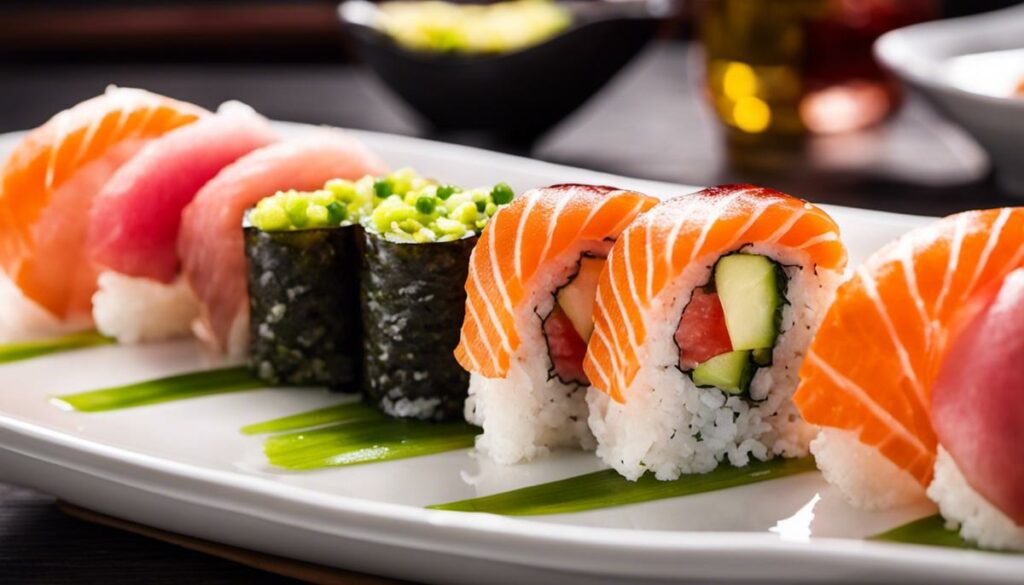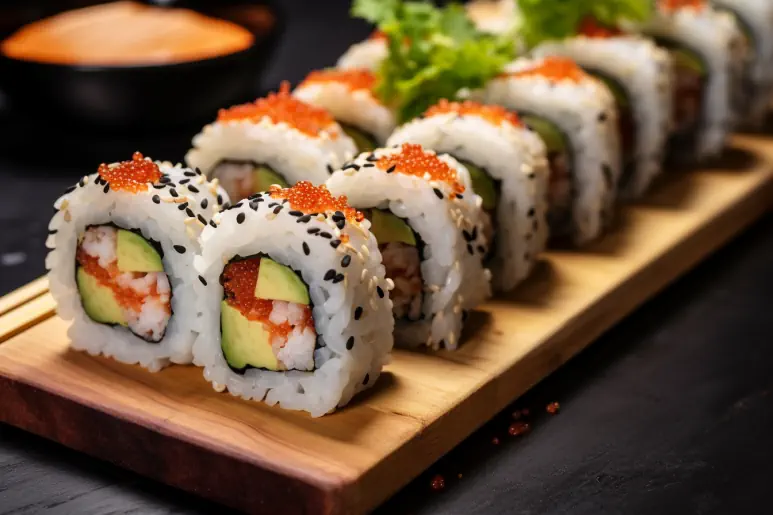The culinary art of Japan is known worldwide and fascinates with its diversity, precision and focus on freshness and quality of ingredients. Sushi rolls and sashimi are two of the most famous and popular dishes that highlight these essential qualities of Japanese cuisine. Although both dishes involve the consumption of raw fish, they differ in their preparation, presentation and enjoyment profile. Let’s dive into the refined world of sushi roll and sashimi to explore their origins, their preparation, their nutritional aspects, as well as their tasting properties.
Definition and Origin of Sushi and Sashimi
Correct definitions and the colorful history of delicate sushi and sashimi are an important preparation for all serious foodies and lifestyle enthusiasts. Since everything here at The Aesthetic Curator is all about finesse, we’re going to dig deeper into the history and definition of sushi and sashimi.
First of all, sushi is definitely one of the most sought-after and refined delicacies known, often highly praised by almost everyone. But where does it actually come from? It is important to know that sushi does not originally come from Japan, but from Southeast Asia. Sushi began as a kind of method of preserving fish through fermentation and after that, sushi and rice were consumed separately. It wasn’t until later, in the 17th century, that the process was shortened and that’s how modern sushi as we know it today came into being.
The definition of sushi is also a point of interest. Sushi generally refers to all dishes that use vinegar rice. This rice, usually seasoned with absolutely perfectly balanced proportions of salt, sugar and vinegar, is the backbone of sushi. While some sushi variations include raw fish, it’s not a staple of all sushi roll recipes.
On the other hand, there is Sashimi. The origin of sashimi is rather blurry, but is traditionally related to Japan. This work of art of Japanese gastronomy is the result of masterful skill and loving attention to detail.
Sashimi is defined as thin slices of raw, edible fish, often high-fat fish or seafood, beautifully arranged on a plate. Unlike sushi, however, sashimi is served without rice.
Exciting, isn’t it? Sushi and sashimi are more than just delicious, Instagram-worthy dishes. They both have a deep, rich history and play a crucial role in the world of gastronomy. Matching the noble taste and refined style of a chic personality like The Aesthetic Curator – it’s always important to stay informed and on-trend. That’s why we strive to inform and inspire our readers in a pointed and engaging way with every post. Enjoy your meal!
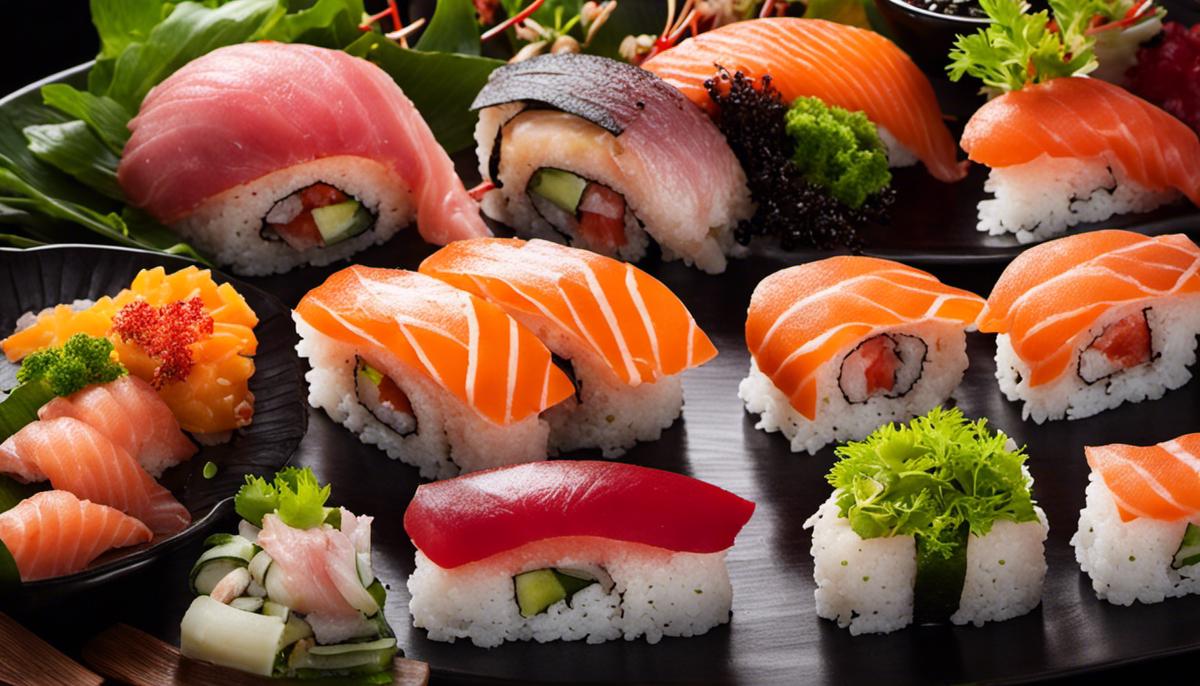
Preparation and ingredients of sushi roll and sashimi
Now that we know the background of sushi and sashimi well, let’s go into the details of the main ingredients and preparation of these highly prized Japanese dishes.
Sushi rolls primarily consist of a base of special rice, known as sushi rice, seasoned with rice vinegar, salt, and sugar. This rice offers the perfect consistency and flavor that harmonizes well with the other ingredients. A key ingredient is nori, a type of roasted seaweed leaves that are extremely versatile and perfect for sushi rolls. Nori gives the whole thing structure and the unmistakable aroma.
A well-made sushi roll often contains some type of seafood, often fresh raw fish such as tuna, salmon, or eel. However, don’t underestimate the use of shrimp, crabs, or even grilled meat in case you don’t prefer fish. Alongside this, of course, there are vegetarian and vegan options that focus on side dishes such as avocado, cucumber, carrots, and even pickled pumpkin.
What about sashimi, you might ask? Sashimi refers to fresh, raw fish or seafood that is carefully considered, finely sliced and often served on a bed of daikon radish. In this dish, the main focus is on the quality of the fish, which must be absolutely fresh.
Tuna, salmon, sea urchins, scallops, and squid are just a few of the varieties used for sashimi. The care in the preparation, the sharp knife art that prepares each fish in the cleanest, smoothest slices, is a testament to the artistry that goes along with a perfect sashimi dish.
The finishing touch to sushi and sashimi is usually wasabi and soy sauce, which enrich the food and can be customized according to your preferences. Sushi and sashimi aren’t just dishes – they’re an art form and a culinary experience to be enjoyed, appreciated, and respected. They embody the minimalism and aesthetics that make Japanese culture so unique, but at the same time, they are universally endearing. Let’s toast to these beautiful culinary works of art!
A final word: it is always advisable to source sushi and sashimi only from trusted local restaurants or delivery services to ensure the highest quality and safety. Now you’re ready to conquer the world of sushi rolls and sashimi dishes! Enjoy your meal!
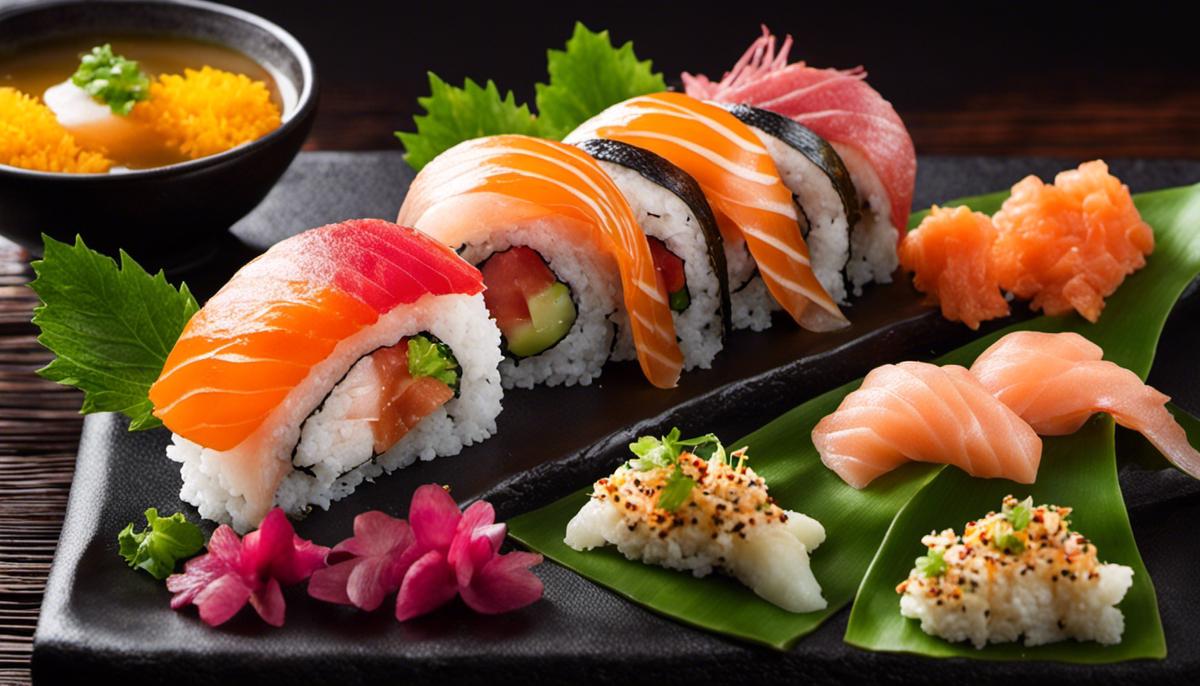
Nutritional Aspects of Sushi Roll and Sashimi
A key to the success of any elegant lifestyle guru is a conscious, healthy eating behavior. Taking into account quality, nutritional content and aesthetics, the choice of food is defined. One such gem that masterfully combines these criteria is undeniably the combination of sushi and sashimi. But how healthy are these two delicacies exactly?
It is widely known that sushi and sashimi are excellent sources of protein. Thanks to the fish they contain, they cover an enormous part of the daily protein requirement. But there are also other essential nutrients in the little works of art: omega-3 fatty acids, for example, which are good for the heart and support cardiovascular health. The vitamin D present in fish, which is essential for healthy bones and a strong immune system, also reaches the plate in an appetizing way.
However, it is important not to consume blindly. Because although at first glance it seems like they are only healthy ingredients, it is important to pay attention to other aspects as well. After all, many sushi rolls are filled with mayonnaise or fried ingredients that drive up the calorie content.
Another point is the soy sauce used. Provided that you don’t overdo it, it’s an enrichment of taste. However, you should be aware that it contains a lot of salt and can increase the risk of high blood pressure if it is too high.
Consuming sashimi, in turn, raises health concerns regarding potential parasites. To be sure that the raw fish is safe for consumption, it is extremely important to check that it has been properly cooled and stored. In addition, it is important to know that not all types of fish are suitable for raw consumption. It is important to always be well informed.
An extra plus point for health can be found in vegetarian or vegan sushi variants. Instead of fish, for example, tofu, avocado or vegetables are used. These not only contain fewer calories, but also score with plenty of fiber and vitamins.
Ultimately, it’s important to be aware that sushi and sashimi isn’t just about the food, it’s about an overall experience. Every detail, every component plays a role in the successful combination of taste, texture and visual presentation. Varied and consciously enjoyed, sushi and sashimi are an exquisite experience and can also be an enjoyable way to eat healthily. But as with everything, it’s the quantity that makes the poison. Sushi and sashimi can be a part of a balanced diet, but they should not be used as the sole source of nutrition. The recommendation remains to consume these delicacies with pleasure and in moderation.
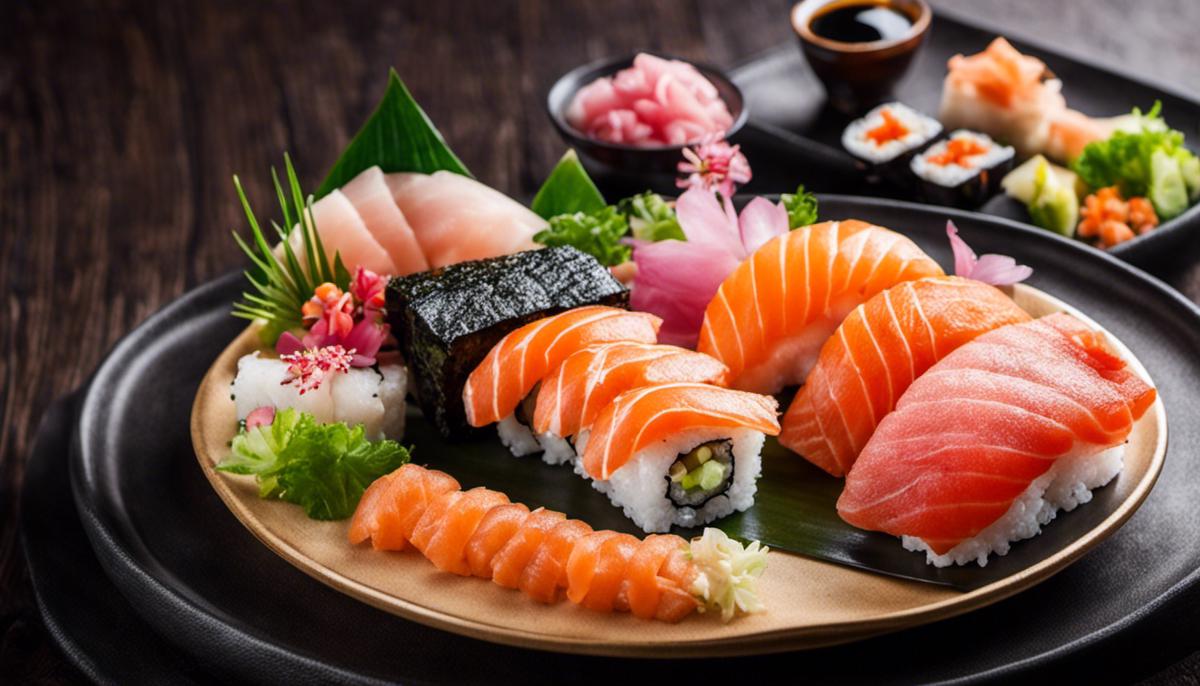
Tasting and enjoyment of sushi roll and sashimi
How to enjoy sushi and sashimi in the best possible way – tips for a perfect tasting
Now that we know about the versatility of sushi and sashimi, the choice of ingredients, and the preparation methods, it’s time to tackle the enjoyment and tasting of these culinary works of art.
If you want to enjoy sushi and sashimi, you should be aware that it’s not just about getting full. It is a culinary experience – a symphony of colours, textures and flavours, all aimed at enchanting and delighting the senses.
The first tip for a successful tasting is to eat the pieces in the right order. Sushi and sashimi traditionally start with the lightest types of fish and then move on to the fattier ones. This allows you to fully appreciate each individual taste, without the previous one overwhelming the perception of the next.
Another aspect of the art of sushi and sashimi enjoyment concerns the use of soy sauce and wasabi. Both should be used sparingly so as not to mask the subtle flavor of the fish. Remember that the goal is to bring out the flavors, not drown them out.
Now let’s address the aspect of conscious and healthy eating. Sushi and sashimi combine quality, nutritional value, and aesthetics, making them excellent sources of protein and other essential nutrients. However, be aware of the calorie content of sushi rolls, especially if they contain mayonnaise or fried ingredients.
The high salt content of soy sauce can also cause health concerns and increase the risk of high blood pressure. Likewise, attention should be paid to potential parasites in the raw fish. Therefore, it is important that raw fish is properly stored and refrigerated. Keep in mind that not all types of fish are suitable for raw consumption.
Vegetarian or vegan sushi options offer its health benefits. They tend to have a lower calorie content and are rich in fiber and vitamins.
Finally, remember that sushi and sashimi is about a holistic experience that combines taste, texture and visual presentation. Enjoy this experience in moderation and in a balanced way, as part of a healthy diet. Whether you’re a sushi lover, a sashimi connoisseur, or just a curious connoisseur, allow yourself to fully enjoy this unique culinary art form.
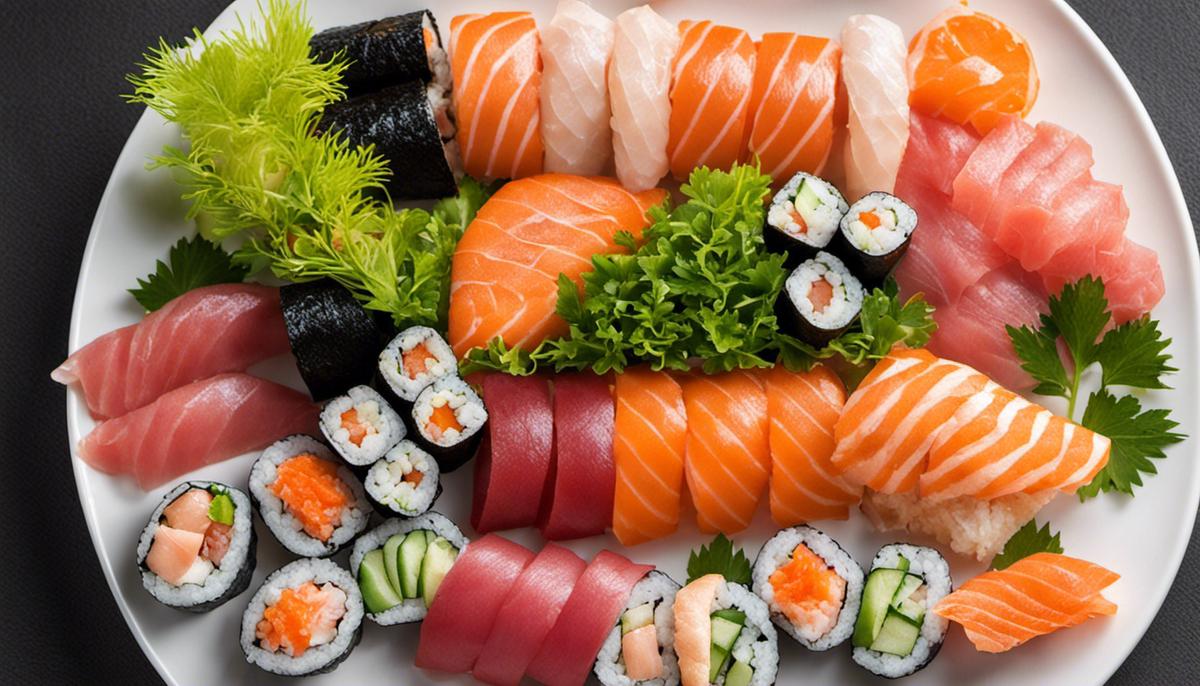
Sushi rolls and sashimi are not only delicious discoveries for the palate, they are also works of art that meet the high aesthetic standards of Japanese culture. They combine taste, texture, colors, and presentation to provide a holistic experience that nourishes both the body and the mind. The right way to eat them and experiencing the subtle nuances and flavors are core elements of this experience. So the next time we sit down at a table to enjoy sushi roll or sashimi, we will not only be amazed by their taste, but appreciate them in their entirety – as an expression of Japanese culture, tradition and gastronomic excellence.
